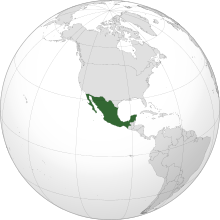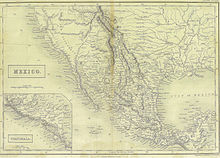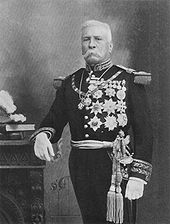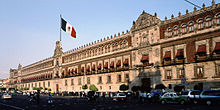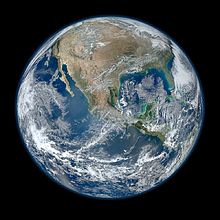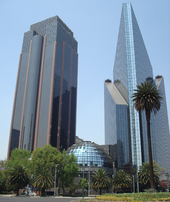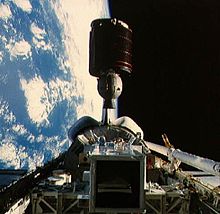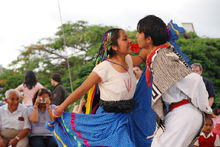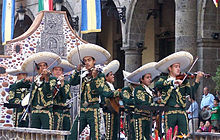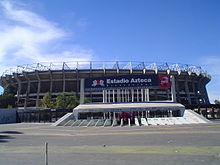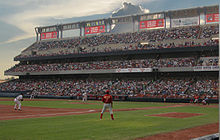
Mexico
Background to the schools Wikipedia
SOS Children produced this website for schools as well as this video website about Africa. SOS mothers each look after a a family of sponsored children.
| United Mexican States Estados Unidos Mexicanos (Spanish)
|
||||||
|---|---|---|---|---|---|---|
|
||||||
| Anthem: Himno Nacional Mexicano Mexican National Anthem |
||||||
National seal: Seal of the United Mexican States |
||||||
|
|
||||||
| Capital and largest city |
Mexico City 19°03′N 99°22′W |
|||||
| National languages |
|
|||||
| Ethnic groups (2010) |
|
|||||
| Demonym | Mexican | |||||
| Government | Federal presidential constitutional republic |
|||||
| - | President | Enrique Peña Nieto | ||||
| - | Secretary of the Interior | Miguel Ángel Osorio Chong | ||||
| - | Supreme Court President | Juan Silva Meza | ||||
| Legislature | Congress | |||||
| - | Upper house | Senate | ||||
| - | Lower house | Chamber of Deputies | ||||
| Independence from Spain | ||||||
| - | Declared | September 16, 1810 | ||||
| - | Recognized | September 27, 1821 | ||||
| Area | ||||||
| - | Total | 1,972,550 km2 ( 14th) 761,606 sq mi |
||||
| - | Water (%) | 2.5 | ||||
| Population | ||||||
| - | 2012 estimate | 115,296,767 ( 11th) | ||||
| - | Density | 57/km2 ( 142nd) 142/sq mi |
||||
| GDP ( PPP) | 2012 estimate | |||||
| - | Total | $1.743 trillion | ||||
| - | Per capita | $15,177 | ||||
| GDP (nominal) | 2012 estimate | |||||
| - | Total | $1.207 trillion | ||||
| - | Per capita | $10,514 | ||||
| Gini (2008) | 48.3 high |
|||||
| HDI (2012) | high · 61th |
|||||
| Currency | Peso ( MXN) |
|||||
| Time zone | See Time in Mexico ( UTC−8 to −6) | |||||
| - | Summer ( DST) | varies ( UTC−7 to −5) | ||||
| Drives on the | right | |||||
| Calling code | +52 | |||||
| ISO 3166 code | MX | |||||
| Internet TLD | .mx | |||||
Mexico ( / ˈ m ɛ k s ɨ k oʊ /; Spanish: México; IPA: [ˈme.xi.ko]), officially the United Mexican States (Spanish: Estados Unidos Mexicanos), is a federal constitutional republic in North America. It is bordered on the north by the United States of America; on the south and west by the Pacific Ocean; on the southeast by Guatemala, Belize, and the Caribbean Sea; and on the east by the Gulf of Mexico. Covering almost two million square kilometres (over 760,000 sq mi), Mexico is the fifth largest country in the Americas by total area and the 13th largest independent nation in the world. With an estimated population of over 113 million, it is the world's eleventh most populous country and the most populous Spanish-speaking country. Mexico is a federation comprising thirty-one states and a Federal District, the capital city.
In pre-Columbian Mexico many cultures matured into advanced civilizations such as the Olmec, the Toltec, the Teotihuacan, the Zapotec, the Maya and the Aztec before first contact with Europeans. In 1521, Spain conquered and colonized the territory from its base in México-Tenochtitlan, which was administered as the Viceroyalty of New Spain. This territory would eventually become Mexico following recognition of the colony's independence in 1821. The post-independence period was characterized by economic instability, the Mexican-American War and territorial cession to the United States, a civil war, two empires and a domestic dictatorship. The latter led to the Mexican Revolution in 1910, which culminated with the promulgation of the 1917 Constitution and the emergence of the country's current political system. Elections held in July 2000 marked the first time that an opposition party won the presidency from the Institutional Revolutionary Party. Since 2006 the country has been in the midst of a drug war which has caused 60,000 deaths.
Mexico has one of the world's largest economies, and is considered both a regional power and middle power. In addition, Mexico was the first Latin American member of the Organisation for Economic Co-operation and Development OECD (since 1994), and considered an upper-middle income country by the World Bank. Mexico is considered a newly industrialized country and an emerging power. It has the thirteenth largest nominal GDP and the eleventh largest GDP by purchasing power parity. The economy is strongly linked to those of its North American Free Trade Agreement (NAFTA) partners, especially the United States of America. Mexico ranks sixth in the world and first in the Americas by number of UNESCO World Heritage Sites with 31, and in 2007 was the tenth most visited country in the world with 21.4 million international arrivals per year.
Etymology
After New Spain won independence from Spain, it was decided that the new country would be named after its capital, Mexico City, which was founded in 1524 on top of the ancient Aztec capital of México-Tenochtitlan. The name comes from the Nahuatl language, but its meaning is unknown.
Mēxihco was the Nahuatl term for the heartland of the Aztec Empire, namely, the Valley of Mexico, and its people, the Mexica, and surrounding territories which became the future State of Mexico as a division of New Spain prior to independence (compare Latium). It is generally considered to be a toponym for the valley which became the primary ethnonym for the Aztec Triple Alliance as a result, or vice versa.
The suffix -co is the Nahuatl locative, making the word a place name. Beyond that, the etymology is uncertain. It has been suggested that it is derived from Mextli or Mēxihtli, a secret name for the god of war and patron of the Aztecs, Huitzilopochtli, in which case Mēxihco means "Place where Huitzilopochtli lives". Another hypothesis suggests that Mēxihco derives from a portmanteau of the Nahuatl words for "Moon" (Mētztli) and navel (xīctli). This meaning ("Place at the Centre of the Moon") might then refer to Tenochtitlan's position in the middle of Lake Texcoco. The system of interconnected lakes, of which Texcoco formed the centre, had the form of a rabbit, which the Mesoamericans pareidolically associated with the Moon. Still another hypothesis suggests that it is derived from Mēctli, the goddess of maguey.
The name of the city-state was transliterated to Spanish as México with the phonetic value of the letter
The official name of the country has changed as the form of government has changed. On two occasions (1821–1823 and 1863–1867), the country was known as Imperio Mexicano ( Mexican Empire). All three federal constitutions (1824, 1857 and 1917, the current constitution) used the name Estados Unidos Mexicanos—or the variants Estados Unidos mexicanos and Estados-Unidos Mexicanos, all of which have been translated as "United Mexican States". The phrase República Mexicana, "Mexican Republic", was used in the 1836 Constitutional Laws. On 22 November 2012, president Felipe Calderón sent to the Mexican Congress a piece of legislation to change the country's name officially to simply Mexico. To go into effect, the bill would need to be passed by both houses of Congress, as well as a majority of Mexico's 31 State legislatures. As this legislation was proposed just a week before Calderón turned power over to Enrique Peña Nieto, Calderón's critics saw this as a symbolic gesture.
History
Ancient cultures
Archaic period
The earliest human remains in Mexico are chips of stone tools found near campfire remains in the Valley of Mexico and radiocarbon-dated to circa 23,000 years ago. Mexico is the site of the domestication of maize and beans which caused a transition from paleo-Indian hunter-gatherers to sedentary agricultural villages beginning around 7000 BCE.
Classic periods
In the subsequent formative areas maize cultivation and cultural traits such as a complex mythological and religious complex, a vigesimal numeric system, were diffused from the Mexican cultures to the rest of the Mesoamerican culture area. In this period villages began to become socially stratified and develop into chiefdoms, and the development of large ceremonial centers.
Among the earliest complex civilizations in Mexico was the Olmec culture which flourish on the Gulf Coast from around 1500 BCE. Olmec cultural traits diffused through Mexico into other formative era cultures in Chiapas, Oaxaca and the Valley of Mexico. The formative period saw the spread of distinct religious and symbolic traditions, as well as artistic and architectural complexes. In the subsequent pre-classical period, the Maya and Zapotec civilizations developed complex centers at Calakmul and Monte Albán respectively. During this period the first true Mesoamerican writing systems were developed in the Epi-Olmec and the Zapotec cultures, and the Mesoamerican writing tradition reached its height in the Classic Maya Hieroglyphic script.
In Central Mexico, the height of the classic period saw the ascendancy of Teotihuacan, which formed a military and commercial empire whose political influence stretched south into the Maya area as well as north. At its peak, Teotihuacan, containing some of the largest pyramidal structures built in the pre-Columbian Americas, had a population of more than 150,000 people. At the collapse of Teotihuacán around 600 CE, competition between several important political centers in central Mexico such as Xochicalco and Cholula ensued. At this time during the Epi-Classic Nahua peoples began moving south into Mesoamerica from the North, and became politically and culturally dominant in central Mexico, as they displaced speakers of Oto-Manguean languages.
Post-classic period
During the early post-classic Central Mexico was dominated by the Toltec culture, Oaxaca by the Mixtec and the lowland Maya area had important centers at Chichén Itzá and Mayapán. Towards the end of the post-Classic period the Aztecs of Central Mexico built a tributary empire covering most of central Mexico. The Aztecs were noted for practicing human sacrifice on a large scale. The distinct Mesoamerican cultural tradition ended with the Spanish conquest in the 16th century, and over the next centuries Mexican indigenous cultures were gradually subjected to Spanish colonial rule.
Conquest
The Spanish conquest of the Aztec Empire began in February 1519 when Hernán Cortés arrived at the port in Veracruz with ca. 500 conquistadores, and later moved on to the Aztec capital. On his search for gold and other riches, Cortés decided to invade and conquer the Aztec empire.
The ruler of the Aztec empire upon the arrival of the Spaniards was Moctezuma II, who was later killed; his successor and brother Cuitláhuac took control of the Aztec empire, but was among the first to fall from the smallpox epidemic a short time later. Unintentionally introduced by Spanish conquerors, smallpox ravaged Mesoamerica in the 1520s, killing more than 3 million Aztecs. Other sources, however, mentioned that the death toll of the Aztecs might have reached up to 15 million (out of a population of less than 30 million). Severely weakened, the Aztec empire was easily defeated by Cortés and his forces on his second return. Smallpox was a devastatingly selective disease—it generally only killed the Aztecs, while the Spaniards were immune to the disease. The deaths caused by smallpox are believed to have triggered a rapid growth of Christianity in Mexico and the Americas. At first, the Aztecs believed the epidemic was a punishment from an angry god, but they later accepted their fate and no longer resisted the Spanish rule. Many of the surviving Aztecs blamed the cause of smallpox to the superiority of the Christian god, which resulted in the acceptance of Catholicism and yielding to the Spanish rule throughout Mexico.
The territory became part of the Spanish Empire under the name of New Spain. Mexico City was systematically rebuilt by Cortés following the Fall of Tenochtitlan in 1521. Much of the identity, traditions and architecture of Mexico were created during the colonial period.
Independence

On September 16, 1810, independence from Spain was declared by priest Miguel Hidalgo y Costilla, in the small town of Dolores, Guanajuato. The first insurgent group was formed by Hidalgo, the Spanish viceregal army captain Ignacio Allende, the militia captain Juan Aldama and "La Corregidora" Josefa Ortiz de Domínguez. Hidalgo and some of his soldiers were captured and executed by firing squad in Chihuahua, on July 31, 1811. Following his death, the leadership was assumed by priest José María Morelos, who occupied key southern cities.
In 1813 the Congress of Chilpancingo was convened and, on November 6, signed the " Solemn Act of the Declaration of Independence of Northern America". Morelos was captured and executed on December 22, 1815. In subsequent years, the insurgency was near collapse, but in 1820 Viceroy Juan Ruiz de Apodaca sent an army under the criollo general Agustín de Iturbide against the troops of Vicente Guerrero. Instead, Iturbide approached Guerrero to join forces, and on August 24, 1821 representatives of the Spanish Crown and Iturbide signed the " Treaty of Córdoba" and the " Declaration of Independence of the Mexican Empire", which recognized the independence of Mexico under the terms of the " Plan of Iguala".
Juárez reforms and territorial losses
Agustín de Iturbide immediately proclaimed himself emperor of the First Mexican Empire. A revolt against him in 1823 established the United Mexican States. In 1824, a Republican Constitution was drafted and Guadalupe Victoria became the first president of the newly born country. The first decades of the post-independence period were marked by economic instability, which led to the Pastry War in 1836, and a constant strife between liberales, supporters of a federal form of government, and conservadores, proposals of a hierarchical form of government.
General Antonio López de Santa Anna, a centralist and two-time dictator, approved the Siete Leyes in 1836, a radical amendment that institutionalized the centralized form of government. When he suspended the 1824 Constitution, civil war spread across the country, and three new governments declared independence: the Republic of Texas, the Republic of the Rio Grande and the Republic of Yucatán.
Texas successfully achieved independence and was annexed by the United States. A border dispute led to the Mexican-American War, which began in 1846 and lasted for two years; the War was settled via the Treaty of Guadalupe Hidalgo, which forced Mexico to give up over half of its land to the U.S., including Alta California, New Mexico, and the disputed parts of Texas. A much smaller transfer of territory in what is today southern Arizona and southwestern New Mexico — the Gadsden Purchase — occurred in 1854. The Caste War of Yucatán, the Mayan uprising that began in 1847, was one of the most successful modern Native American revolts. Maya rebels, or Cruzob, maintained relatively independent enclaves until the 1930s.
Dissatisfaction with Santa Anna's return to power led to the liberal " Plan of Ayutla", initiating an era known as La Reforma, after which a new Constitution was drafted in 1857 that established a secular state, federalism as the form of government, and several freedoms. As the conservadores refused to recognize it, the Reform War began in 1858, during which both groups had their own governments. The war ended in 1861 with victory by the Liberals, led by Amerindian president Benito Juárez. In the 1860s Mexico underwent a military occupation by France, which established the Second Mexican Empire under the rule of Habsburg Archduke Ferdinand Maximilian of Austria with support from the Roman Catholic clergy and the conservadores, who later switched sides and joined the liberales. Maximilian surrendered, was tried on June 14 and was executed on June 19, 1867.
Porfiriato
Porfirio Díaz, a republican general during the French intervention, ruled Mexico from 1876 to 1880 and then from 1884 to 1911 in five consecutive reelections, period known as the Porfiriato, characterized by remarkable economic achievements, investments in the arts and sciences, but also of economic inequality and political repression.
Mexican Revolution
A likely electoral fraud that led to Diaz' fifth reelection sparked the 1910 Mexican Revolution, initially led by Francisco I. Madero.
Díaz resigned in 1911 and Madero was elected president but overthrown and murdered in a coup d'État two years later directed by conservative general Victoriano Huerta. That event re-ignited the civil war, involving figures such as Francisco Villa and Emiliano Zapata, who formed their own forces. A third force, the constitutional army led by Venustiano Carranza managed to bring an end to the war, and radically amended the 1857 Constitution to include many of the social premises and demands of the revolutionaries into what was eventually called the 1917 Constitution. It is estimated that the war killed 900,000 of the 1910 population of 15 million. Assassinated in 1920, Carranza was succeeded by another revolutionary hero, Álvaro Obregón, who in turn was succeeded by Plutarco Elías Calles. Obregón was reelected in 1928 but assassinated before he could assume power.
PRI rule

In 1929, Calles founded the National Revolutionary Party (PNR), later renamed the Institutional Revolutionary Party (PRI), and started a period known as the Maximato, which ended with the election of Lázaro Cárdenas, who implemented many economic and social reforms, and most significantly expropriated the oil industry into Pemex on March 18, 1938, but sparked a diplomatic crisis with the countries whose citizens had lost businesses by Cárdenas' radical measure.
Between 1940 and 1980, Mexico experienced a substantial economic growth that some historians call the " Mexican miracle". Although the economy continued to flourish, social inequality remained a factor of discontent. Moreover, the PRI rule became increasingly authoritarian and at times oppressive (see the 1968 Tlatelolco massacre, which claimed the life of around 30–800 protesters).
Electoral reforms and high oil prices followed the administration of Luis Echeverría, mismanagement of these revenues led to inflation and exacerbated the 1982 Crisis. That year, oil prices plunged, interest rates soared, and the government defaulted on its debt. President Miguel de la Madrid resorted to currency devaluations which in turn sparked inflation.
In the 1980s the first cracks emerged in PRI's monopolistic position. In Baja California, Ernesto Ruffo Appel was elected as governor. In 1988, electoral fraud prevented leftist candidate Cuauhtémoc Cárdenas from winning the national presidential elections, giving Carlos Salinas de Gortari the presidency and leading to massive protests in Mexico City.
Salinas embarked on a program of neoliberal reforms which fixed the exchange rate, controlled inflation and culminated with the signing of the North American Free Trade Agreement (NAFTA), which came into effect on January 1, 1994. The same day, the Zapatista Army of National Liberation (EZLN) started a two-week-long armed rebellion against the federal government, and has continued as a non-violent opposition movement against neoliberalism and globalization.
Democratization
In December 1994, a month after Salinas was succeeded by Ernesto Zedillo, the Mexican economy collapsed, with a rapid rescue packaged authorized by U.S. President Bill Clinton and major macroeconomic reforms started by president Zedillo, the economy rapidly recovered and growth peaked at almost 7% by the end of 1999.
In 2000, after 71 years, the PRI lost a presidential election to Vicente Fox of the opposition National Action Party (PAN). In the 2006 presidential election, Felipe Calderón from the PAN was declared the winner, with a very narrow margin over leftist politician Andrés Manuel López Obrador of the Party of the Democratic Revolution (PRD). López Obrador, however, contested the election and pledged to create an "alternative government".
Administrative divisions
The United Mexican States are a federation of 31 free and sovereign states, which form a union that exercises a degree of jurisdiction over the Federal District and other territories.
Each state has its own constitution, congress, and a judiciary, and its citizens elect by direct voting a governor for a six-year term, and representatives to their respective unicameral state congresses for three-year terms.
The Federal District is a special political division that belongs to the federation as a whole and not to a particular state, and as such, has more limited local rule than the nation's states.
The states are divided into municipalities, the smallest administrative political entity in the country, governed by a mayor or municipal president (presidente municipal), elected by its residents by plurality.
California
California
Sur
León
Roo
|
|
Politics
The United Mexican States are a federation whose government is representative, democratic and republican based on a presidential system according to the 1917 Constitution. The constitution establishes three levels of government: the federal Union, the state governments and the municipal governments. According to the constitution, all constituent states of the federation must have a republican form of government composed of three branches: the executive, represented by a governor and an appointed cabinet, the legislative branch constituted by a unicameral congress and the judiciary, which will include called state Supreme Court of Justice. They also have their own civil and judicial codes.
The bicameral Congress of the Union, composed of a Senate and a Chamber of Deputies, makes federal law, declares war, imposes taxes, approves the national budget and international treaties, and ratifies diplomatic appointments. Seats to federal and state legislatures are elected by a system of parallel voting that includes plurality and proportional representation. The Chamber of Deputies of the Congress of the Union is conformed by 300 deputies elected by plurality and 200 deputies by proportional representation with closed party lists for which the country is divided into 5 electoral constituencies or circumscriptions. The Senate is conformed by a total of 128 senators: 64 senators, two for each state and two for the Federal District, elected by plurality in pairs; 32 senators assigned to the first minority or first-runner up (one for each state and one for the Federal District), and 32 are assigned by proportional representation with closed party lists for which the country conforms a single electoral constituency.
The Executive, is the President of the United Mexican States, who is the head of state and government, as well as the commander-in-chief of the Mexican military forces. The President also appoints the Cabinet and other officers. The President is responsible for executing and enforcing the law, and has the authority of vetoing bills.
The Judiciary branch of government is the Supreme Court of Justice, comprised by eleven judges appointed by the President with Senate approval, who interpret laws and judge cases of federal competency. Other institutions of the judiciary are the Electoral Tribunal, collegiate, unitary and district tribunals, and the Council of the Federal Judiciary.
Three parties have historically been the dominant parties in Mexican politics: the National Action Party: a right-wing conservative party founded in 1939 and belonging to the Christian Democrat Organization of America; the Institutional Revolutionary Party, a centre-left party and member of Socialist International that was founded in 1929 to unite all the factions of the Mexican Revolution and held an almost hegemonic power in Mexican politics since then; the Party of the Democratic Revolution: a left-wing party, founded in 1989 as the successor of the coalition of socialists and liberal parties.
Foreign relations

The foreign relations of Mexico are directed by the President of Mexico and managed through the Ministry of Foreign Affairs. The principles of the foreign policy are constitutionally recognized in the Article 89, Section 10, which include: respect for international law and legal equality of states, their sovereignty and independence, non-intervention in the domestic affairs of other countries, peaceful resolution of conflicts, and promotion of collective security through active participation in international organizations. Since the 1930s, the Estrada Doctrine has served as a crucial complement to these principles.
Mexico is one of the founding members of several international organizations, most notably the United Nations, the Organization of American States, the Organization of Ibero-American States, the OPANAL and the Rio Group. In 2008, Mexico contributed over 40 million dollars to the United Nations regular budget. In addition, it was the only Latin American member of the Organisation for Economic Co-operation and Development since it joined in 1994 until Chile gained full membership in 2010. Mexico is considered as a regional power hence its presence in major economic groups such as the G8+5 and the G-20. In addition, since the 1990s Mexico has sought a reform of the United Nations Security Council and its working methods with the support of Canada, Italy, Pakistan and other nine countries, which form a group informally called the Coffee Club.
After the War of Independence, the relations of Mexico were focused primarily on the United States, its northern neighbour, largest trading partner, and the most powerful actor in hemispheric and world affairs. Mexico supported the Cuban government since its establishment in the early 1960s, the Sandinista revolution in Nicaragua during the late 1970s, and leftist revolutionary groups in El Salvador during the 1980s. Felipe Calderón's administration put a greater emphasis on relations with Latin America and the Caribbean.
Military
The Mexican Armed Forces have two branches: the Mexican Army (which includes the Mexican Air Force), and the Mexican Navy. The Mexican Armed Forces maintain significant infrastructure, including facilities for design, research, and testing of weapons, vehicles, aircraft, naval vessels, defense systems and electronics; military industry manufacturing centers for building such systems, and advanced naval dockyards that build heavy military vessels and advanced missile technologies.
In recent years, Mexico has improved its training techniques, military command and information structures and has taken steps to becoming more self-reliant in supplying its military by designing as well as manufacturing its own arms, missiles, aircraft, vehicles, heavy weaponry, electronics, defense systems, armor, heavy military industrial equipment and heavy naval vessels. Since the 1990s, when the military escalated its role in the war on drugs, increasing importance has been placed on acquiring airborne surveillance platforms, aircraft, helicopters, digital war-fighting technologies, urban warfare equipment and rapid troop transport.
Mexico has the capabilities to manufacture nuclear weapons, but forwent this possibility with the Treaty of Tlatelolco in 1968 and pledged to only use its nuclear technology for peaceful purposes. In 1970 Mexico's national institute for nuclear research successfully refined weapons grade uranium which is used in the manufacture of nuclear weapons but in April 2010, Mexico agreed to turn over its weapons grade uranium to the United States.
Historically, Mexico has remained neutral in international conflicts, with the exception of World War II. However, in recent years some political parties have proposed an amendment of the Constitution in order to allow the Mexican Army, Air Force or Navy to collaborate with the United Nations in peacekeeping missions, or to provide military help to countries that officially ask for it.
Geography
Mexico is located between latitudes 14° and 33°N, and longitudes 86° and 119°W in the southern portion of North America. Almost all of Mexico lies in the North American Plate, with small parts of the Baja California peninsula on the Pacific and Cocos Plates. Geophysically, some geographers include the territory east of the Isthmus of Tehuantepec (around 12% of the total) within Central America. Geopolitically, however, Mexico is entirely considered part of North America, along with Canada and the United States.
Mexico's total area is 1,972,550 km2 (761,606 sq mi), making it the world's 14th largest country by total area, and includes approximately 6,000 km2 (2,317 sq mi) of islands in the Pacific Ocean (including the remote Guadalupe Island and the Revillagigedo Islands), Gulf of Mexico, Caribbean, and Gulf of California. From its farthest land points, Mexico is a little over 2,000 mi (3,219 km) in length.
On its north, Mexico shares a 3,141 km (1,952 mi) border with the United States. The meandering Río Bravo del Norte (known as the Rio Grande in the United States) defines the border from Ciudad Juárez east to the Gulf of Mexico. A series of natural and artificial markers delineate the United States-Mexican border west from Ciudad Juárez to the Pacific Ocean. On its south, Mexico shares an 871 km (541 mi) border with Guatemala and a 251 km (156 mi) border with Belize.
Mexico is crossed from north to south by two mountain ranges known as Sierra Madre Oriental and Sierra Madre Occidental, which are the extension of the Rocky Mountains from northern North America. From east to west at the centre, the country is crossed by the Trans-Mexican Volcanic Belt also known as the Sierra Nevada. A fourth mountain range, the Sierra Madre del Sur, runs from Michoacán to Oaxaca.
As such, the majority of the Mexican central and northern territories are located at high altitudes, and the highest elevations are found at the Trans-Mexican Volcanic Belt: Pico de Orizaba (5,700 m, 18,701 ft), Popocatepetl (5,462 m, 17,920 ft) and Iztaccihuatl (5,286 m, 17,343 ft) and the Nevado de Toluca (4,577 m, 15,016 ft). Three major urban agglomerations are located in the valleys between these four elevations: Toluca, Greater Mexico City and Puebla.
Climate
The Tropic of Cancer effectively divides the country into temperate and tropical zones. Land north of the twenty-fourth parallel experiences cooler temperatures during the winter months. South of the twenty-fourth parallel, temperatures are fairly constant year round and vary solely as a function of elevation. This gives Mexico one of the world's most diverse weather systems.
Areas south of the 24th parallel with elevations up to 1,000 m (3,281 ft) (the southern parts of both coastal plains as well as the Yucatán Peninsula), have a yearly median temperature between 24 to 28 °C (75.2 to 82.4 °F). Temperatures here remain high throughout the year, with only a 5 °C (9 °F) difference between winter and summer median temperatures. Both Mexican coasts, except for the south coast of the Bay of Campeche and northern Baja, are also vulnerable to serious hurricanes during the summer and fall. Although low-lying areas north of the 24th parallel are hot and humid during the summer, they generally have lower yearly temperature averages (from 20 to 24 °C or 68 to 75.2 °F) because of more moderate conditions during the winter.
Many large cities in Mexico are located in the Valley of Mexico or in adjacent valleys with altitudes generally above 2,000 m (6,562 ft). This gives them a year-round temperate climate with yearly temperature averages (from 16 to 18 °C or 60.8 to 64.4 °F) and cool nighttime temperatures throughout the year.
Many parts of Mexico, particularly the north, have a dry climate with sporadic rainfall while parts of the tropical lowlands in the south average more than 2,000 mm (78.7 in) of annual precipitation. For example, many cities in the north like Monterrey, Hermosillo, and Mexicali experience temperatures of 40 °C (104 °F) or more in summer. In the Sonoran Desert temperatures reach 50 °C (122 °F) or more.
In 2012, Mexico passed a comprehensive climate change bill, a first in the developing world, that has set a goal for the country to generate 35% of its energy from clean energy sources by 2024, and to cut emissions by 50% by 2050, from the level found in 2000.
Biodiversity
Mexico is one of the 18 megadiverse countries of the world. With over 200,000 different species, Mexico is home of 10–12% of the world's biodiversity. Mexico ranks first in biodiversity in reptiles with 707 known species, second in mammals with 438 species, fourth in amphibians with 290 species, and fourth in flora, with 26,000 different species. Mexico is also considered the second country in the world in ecosystems and fourth in overall species. Approximately 2,500 species are protected by Mexican legislations.

As of 2002, Mexico had the second fastest rate of deforestation in the world, second only to Brazil. The government has taken another initiative in the late 1990s to expand the people's knowledge, interest and use of the country's esteemed biodiversity, through the Comisión Nacional para el Conocimiento y Uso de la Biodiversidad.
In Mexico, 170,000 square kilometres (65,637 sq mi) are considered "Protected Natural Areas." These include 34 biosphere reserves (unaltered ecosystems), 67 national parks, 4 natural monuments (protected in perpetuity for their aesthetic, scientific or historical value), 26 areas of protected flora and fauna, 4 areas for natural resource protection (conservation of soil, hydrological basins and forests) and 17 sanctuaries (zones rich in diverse species).
The discovery of the Americas brought to the rest of the world many widely used food crops and edible plants. Some of Mexico's native culinary ingredients include: chocolate, avocado, tomato, maize, vanilla, guava, chayote, epazote, camote, jícama, nopal, zucchini, tejocote, huitlacoche, sapote, mamey sapote, many varieties of beans, and an even greater variety of chiles, such as the habanero and the jalapeño. Most of these names come from indigenous languages like Nahuatl.
Due to its high biodiversity Mexico has also been a frequent site of bioprospecting by international research bodies. The first highly successful instance being the discovery in 1947 of the tuber " Barbasco" ( Dioscorea composita) which has a high content of diosgenin, revolutionizing the production of synthetic hormones in the 1950es and 1960es and eventually leading to the invention of combined oral contraceptive pills.
Economy

Mexico has the 13th largest nominal GDP and the 11th largest by purchasing power parity. GDP annual average growth for the period of 1995–2002 was 5.1%. Foreign debt decreased to less than 20% of GDP. 17% of the population lives below Mexico's own poverty line, ranking behind Kazakhstan, Bulgaria and Thailand. The overall poverty rate however is 44.2%, while a full 70% lack one of the 8 economic indicators used to define poverty by the Mexican government. From the late 1990s, the majority of the population has been part of the growing middle class. But from 2004 to 2008 the portion of the population who received less than half of the median income has risen from 17% to 21% and the absolute levels of poverty have risen considerably from 2006 to 2010, with a rise in persons living in extreme or moderate poverty rising from 35 to 46% (52 million persons). This is also reflected by the fact that infant mortality in Mexico is three times higher than the average among OECD nations, and the literacy levels are in the median range of OECD nations. According to Goldman Sachs, by 2050 Mexico will have the 5th largest economy in the world.
Among the OECD countries, Mexico has the second highest degree of economic disparity between the extremely poor and extremely rich, after Chile – although it has been falling over the last decade. The bottom ten percent in the income hierarchy disposes of 1.36% of the country's resources, whereas the upper ten percent dispose of almost 36%. OECD also notes that Mexico's budgeted expenses for poverty alleviation and social development is only about a third of the OECD average – both in absolute and relative numbers.
According to a 2008 UN report the average income in a typical urbanized area of Mexico was $26,654, while the average income in rural areas just miles away was only $8,403. Daily minimum wages are set annually by law and determined by zone; $57.46 Mexican pesos ($5.75 USD) in Zone A ( Baja California, Federal District, State of Mexico, and large cities), $55.84 Mexican pesos ($5.59 USD) in Zone B ( Sonora, Nuevo León, Tamaulipas, Veracruz, and Jalisco), and $54.47 Mexican pesos ($5.45 USD) in Zone C (all other states)
In 2006, trade with the United States and Canada accounted for almost 50% of its exports and 45% of its imports. During the first three quarters of 2010, the United States had a $46.0 billion trade deficit with Mexico. In August 2010 Mexico surpassed France to became the 9th largest holder of US debt. The commercial and financial dependence on the US is a cause for concern. The remittances from Mexican citizens working in the United States account for 0.2% of Mexico's GDP which was equal to US$20 billion per year in 2004 and is the tenth largest source of foreign income after oil, industrial exports, manufactured goods, electronics, heavy industry, automobiles, construction, food, banking and financial services. According to Mexico's central bank, remittances in 2008 amounted to $25bn.
Mexico is the largest North American auto-producing nation, recently surpassing Canada and the U.S. The industry produces technologically complex components and engages in some research and development activities. The "Big Three" ( General Motors, Ford and Chrysler) have been operating in Mexico since the 1930s, while Volkswagen and Nissan built their plants in the 1960s. In Puebla alone, 70 industrial part-makers cluster around Volkswagen. The relatively small domestic car industry is represented by DINA S.A., which has built buses and trucks for almost half a century, and the new Mastretta company that builds the high performance Mastretta MXT sports car.
Major players in the broadcasting industry are Televisa, the largest Spanish media company in the Spanish-speaking world, and TV Azteca.
Tourism
Mexico reports the 23rd highest tourism-based income in the world, and the highest in Latin America. The vast majority of tourists come to Mexico from the United States and Canada followed by Europe and Asia. A smaller number also come from other Latin American countries. In the 2008 Travel and Tourism Competitiveness Index, fifth among Latin American countries, and the ninth in the Americas.
Energy
Energy production in Mexico is managed by state-owned companies: the Federal Commission of Electricity and Pemex.
Pemex, the public company in charge of exploration, extraction, transportation and marketing of crude oil and natural gas, as well as the refining and distribution of petroleum products and petrochemicals, is one of the largest companies in the world by revenue, making US $86 billion in sales a year. Mexico is the sixth-largest oil producer in the world, with 3.7 million barrels per day. In 1980 oil exports accounted for 61.6% of total exports; by 2000 it was only 7.3%.
The largest hydro plant in Mexico is the 2,400 MW Manuel Moreno Torres Dam in Chicoasén, Chiapas, in the Grijalva River. This is the world's fourth most productive hydroelectric plant.
Transportation
The paved-roadway network extended for 116,802 km (72,577 mi) in 2005; 10,474 km (6,508 mi) were multi-lane freeways or expressways, most of which were tollways. Nonetheless, it still cannot meet national needs adequately. Most of the domestic passenger transport needs are served by an extensive bus network.
Mexico was one of the first Latin American countries to promote railway development, and the network covers 30,952 km (19,233 mi). The Secretary of Communications and Transport of Mexico proposed a high-speed rail link that will transport its passengers from Mexico City to Guadalajara, Jalisco. The train, which will travel at 300 kilometers per hour, will allow passengers to travel from Mexico City to Guadalajara in just 2 hours. The whole project was projected to cost 240 billion pesos, or about 25 billion US$ and is being paid for jointly by the Mexican government and the local private sector including the wealthiest man in the world, Mexico's billionaire business tycoon Carlos Slim. The government of the state of Yucatán is also funding the construction of a high speed line connecting the cities of Cozumel to Mérida and Chichen Itza and Cancún.
In 1999, Mexico had 233 airports with paved runways; of these, 35 carry 97% of the passenger traffic. The Mexico City International Airport remains the largest in Latin America and the 44th largest in the world transporting 21 million passengers a year.
Communications
The telecommunications industry is mostly dominated by Telmex (Teléfonos de México), privatized in 1990. As of 2006, Telmex had expanded its operations to Colombia, Peru, Chile, Argentina, Brazil and Uruguay and the United States. Other players in the domestic industry are Axtel and Maxcom. Due to Mexican orography, providing landline telephone service at remote mountainous areas is expensive, and the penetration of line-phones per capita is low compared to other Latin American countries, at 40 percent, however 82% of Mexicans over the age of 14 own a mobile phone. Mobile telephony has the advantage of reaching all areas at a lower cost, and the total number of mobile lines is almost two times that of landlines, with an estimation of 63 million lines. The telecommunication industry is regulated by the government through Cofetel (Comisión Federal de Telecomunicaciones).
The Mexican satellite system is domestic and operates 120 earth stations. There is also extensive microwave radio relay network and considerable use of fibre-optic and coaxial cable. Mexican satellites are operated by Satélites Mexicanos ( Satmex), a private company, leader in Latin America and servicing both North and South America. It offers broadcast, telephone and telecommunication services to 37 countries in the Americas, from Canada to Argentina. Through business partnerships Satmex provides high-speed connectivity to ISPs and Digital Broadcast Services. Satmex maintains its own satellite fleet with most of the fleet being Mexican designed and built.
Usage of radio, television, and Internet in Mexico is prevalent. There are approximately 1,410 radio broadcast stations and 236 television stations (excluding repeaters). Major players in the broadcasting industry are Televisa—the largest media company in the Spanish-speaking world—and TV Azteca.
Science and technology

The National Autonomous University of Mexico was officially established in 1910, and the university become one of the most important institutes of higher learning in Mexico. UNAM provides world class education in science, medicine, and engineering. Many scientific institutes and new institutes of higher learning, such as National Polytechnic Institute (founded in 1936), were established during the first half of the 20th century. Most of the new research institutes were created within UNAM. Twelve institutes were integrated into UNAM from 1929 to 1973. In 1959, the Mexican Academy of Sciences was created to coordinate scientific efforts between academics.
In 1995 Mexican chemist Mario J. Molina shared the Nobel Prize in Chemistry with Paul J. Crutzen, and F. Sherwood Rowland for their work in atmospheric chemistry, particularly concerning the formation and decomposition of ozone. Molina, an alumnus of UNAM, became the first Mexican citizen to win the Nobel Prize in science.
In recent years, the largest scientific project being developed in Mexico was the construction of the Large Millimeter Telescope (Gran Telescopio Milimétrico, GMT), the world's largest and most sensitive single-aperture telescope in its frequency range. It was designed to observe regions of space obscured by stellar dust.
The electronics industry of Mexico has grown enormously within the last decade. In 2007 Mexico surpassed South Korea as the second largest manufacturer of televisions, and in 2008 Mexico surpassed China, South Korea and Taiwan to become the largest producer of smartphones in the world. There are almost half a million (451,000) students enrolled in electronics engineering programs.
Demographics
| Historical populations | ||
|---|---|---|
| Year | Pop. | ±% |
| 1895 | 12,632,427 | — |
| 1900 | 13,607,272 | +7.7% |
| 1910 | 15,160,369 | +11.4% |
| 1921 | 14,334,780 | −5.4% |
| 1930 | 16,552,722 | +15.5% |
| 1940 | 19,653,552 | +18.7% |
| 1950 | 25,791,017 | +31.2% |
| 1960 | 34,923,129 | +35.4% |
| 1970 | 48,225,238 | +38.1% |
| 1980 | 66,846,833 | +38.6% |
| 1990 | 81,249,645 | +21.5% |
| 1995 | 91,158,290 | +12.2% |
| 2000 | 97,483,412 | +6.9% |
| 2005 | 103,263,388 | +5.9% |
| 2010 | 112,336,538 | +8.8% |
| Source: INEGI | ||
The recently conducted 2010 Census showed a population of 112,336,538, making it the most populous Spanish-speaking country in the world.
Mexico is ethnically diverse, the various indigenous peoples and European immigrants are united under a single national identity. The core part of Mexican national identity is formed on the basis of a synthesis of European culture with Indigenous cultures in a process known as mestizaje, alluding to the mixed biological origins of the majority of Mexicans. Mexican politicians and reformers such as José Vasconcelos and Manuel Gamio were instrumental in building a Mexican national identity on the concept of mestizaje. The term mestizo, often used in literature about Mexican social identities, carries a variety of socio-cultural, economic, racial and biological meanings. For this reason it has been deemed too imprecise to be used for ethnic classification and has been abandoned in Mexican censuses.
The category of "indígena" (indigenous) can be defined narrowly according to linguistic criteria including only speakers of one of Mexico's 62 indigenous languages or people who self-identify as having an indigenous cultural background. According to the National Commission for the Development of Indigenous Peoples, as of 2005 there are 10.1 million Mexicans who speak an indigenous language and claim indigenous heritage, representing 9.8% of the total population.
The word "mestizo" is sometimes used with the meaning of a person with mixed indigenous and European blood. This usage does not conform to the Mexican social reality where a person of pure indigenous genetic heritage would be considered Mestizo either by rejecting his indigenous culture or by not speaking an indigenous language, and a person with a very low percentage of indigenous genetic heritage would be considered fully indigenous either by speaking an indigenous language or by identifying with a particular indigenous cultural heritage.
Mexico represents the largest source of immigration to the United States. About 9% of the population born in Mexico is now living in the United States. 28.3 million Americans listed their ancestry as Mexican as of 2006. Per the 2000 U.S. Census, a plurality of 47.3% of Mexican Americans self identify as White, closely followed by Mexican Americans who self identify as "Some other race", usually Mestizo (European/Indian) with 45.5%.
Mexico is home to the largest number of U.S. citizens abroad (estimated at one million as of 1999). The Argentine community is considered to be the second largest foreign community in the country (estimated somewhere between 30,000 and 150,000). Mexico also has a large Lebanese community, now numbering around 400,000. In October 2008, Mexico agreed to deport Cubans using the country as an entry point to the US. Large numbers of Central American migrants who have crossed Guatemala's western border into Mexico are deported every year. Small numbers of illegal immigrants come from Ecuador, Cuba, China, South Africa, and Pakistan.
Indigenous peoples
According to the National Commission for the Development of the Indigenous Peoples (CDI) there are 9,854,301 indigenous people reported in Mexico in 2000, which constitute 9.54% of the population in the country. The absolute indigenous population is growing, but at a slower rate than the rest of the population so that the percentage of indigenous peoples is nonetheless falling. The majority of the indigenous population is concentrated in the central and southern states, that are generally the least developed, and the majority of the indigenous population live in rural areas. Some indigenous communities have a degree of autonomy under the legislation of "usos y costumbres", which allows them to regulate some internal issues under customary law. According to the CDI, the states with the greatest percentage of indigenous population are: Yucatán, with 59%, Quintana Roo with 39% and Campeche with 27% of the population being indigenous, most of them Maya; Oaxaca with 48% of the population, the most numerous groups being the Mixtec and Zapotec peoples; Chiapas has 28%, the majority being Tzeltal and Tzotzil Maya; Hidalgo with 24%, the majority being Otomi; Puebla with 19%, and Guerrero with 17%, mostly Nahua people and the states of San Luis Potosí and Veracruz both home to a population of 15% indigenous people, mostly from the Totonac, Nahua and Teenek (Huastec) groups.
All of the indices of social development for the indigenous population are considerably lower than the national average. In all states indigenous people have higher infant mortality, in some states almost double of the non-indigenous populations. Literacy rates are also much lower, with 27% of indigenous children between 6 and 14 being illiterate compared to a national average of 12%. The indigenous population participate in the workforce longer than the national average, starting earlier and continuing longer. However, 55% of the indigenous population receive less than a minimum salary, compared to 20% for the national average. Many practice subsistence agriculture and receive no salaries. Indigenous people also have less access to health care and a lower quality of housing.
Population genetics
A study by the National Institute of Genomic Medicine, Mexico reported that Mestizo Mexicans are 58.96% European, 35.05% "Asian" (Amerindian), and 5.03% African. Sonora shows the highest European contribution (70.63%) and Guerrero the lowest (51.98%) where we also observe the highest Asian contribution (37.17%). African contribution ranges from 2.8% in Sonora to 11.13% in Veracruz. 80% of the Mexican population was classed as mestizo (defined as "being racially mixed in some degree").
In May 2009, Mexico's National Institute of Genomic Medicine issued a report on a genomic study of 300 mestizos from the states of Guerrero, Sonora, Veracruz, Yucatán, Zacatecas, and Guanajuato. The study found that the Mestizo population of these Mexican states were on average 55% of indigenous ancestry followed by 41.8% of European, 1.8% of African, and 1.2% of East Asian ancestry. The study also noted that whereas Mestizo individuals from the southern state of Guerrero showed on average 66% of indigenous ancestry, those from the northern state of Sonora displayed about 61.6% European ancestry. The study found that there was an increase in indigenous ancestry as one traveled towards to the Southern states in Mexico, while the indigenous ancestry declined as one traveled to the Northern states in the country, such as Sonora.
Languages
The country has the largest Spanish-speaking population in the world with almost a third of all Spanish native speakers.
Mexico is home to a large number of indigenous languages, spoken by some 5.4% of the population – 1.2% of the population are monolingual speakers of an indigenous language. The indigenous languages with most speakers are Nahuatl, spoken by approximately 1.45 million people, Yukatek Maya spoken by some 750,000 people and the Mixtec and Zapotec languages each spoken by more than 400,000 people. The National Institute of Indigenous Languages INALI recognizes 68 linguistic groups and some 364 different specific varieties of indigenous languages. Since the promulgation of the Law of Indigenous Linguistic Rights in 2003, these languages have had status as national languages, with equal validity with Spanish in all the areas and contexts in which they are spoken.
In addition to the indigenous languages, other minority languages are spoken by immigrant populations, such as the 80,000 German-speaking Mennonites in Mexico., and 5,000 the Chipilo dialect of the Venetian language spoken in Chipilo, Puebla.
Religion
The 2010 census by the Instituto Nacional de Estadística y Geografía gave Roman Catholicism as the main religion, with 82.7% of the population, while 9.7% (10,924,103) belong to other Christian denominations, including Evangelicals (5.2%); Pentecostals (1.6%); other Protestant or Reformed (0.7%); Jehovah's Witnesses (1.4%); Seventh-day Adventists (0.6%); and members of The Church of Jesus Christ of Latter-day Saints (0.3%). 172,891 (or less than 0.2% of the total) belonged to other, non-Christian religions; 4.7% declared having no religion; 2.7% were unspecified.
The 92,924,489 Catholics of Mexico constitute in absolute terms the second largest Catholic community in the world, after Brazil's. 47% percent of them attend church services weekly. Most Mexican cities, towns and villages hold a yearly feast day to commemorate their local patron saints. The feast day of Our Lady of Guadalupe, the patron saint of Mexico, is celebrated on December 12 and is regarded by many Mexicans as the most important religious holiday of their country.
The 2010 census reported 314,932 members of The Church of Jesus Christ of Latter-day Saints, though the church in 2009 claimed to have over one million registered members. About 25% of registered members attend a weekly sacrament service although this can fluctuate up and down.
The presence of Jews in Mexico dates back to 1521, when Hernán Cortés conquered the Aztecs, accompanied by several Conversos. According to the 2010 census, there are 67,476 Jews in Mexico. Islam in Mexico is practiced by a small population in the city of Torreón, Coahuila, and there are an estimated 300 Muslims in the San Cristóbal de las Casas area in Chiapas. In the 2010 census 18,185 Mexicans reported belonging to an Eastern religion, a category which includes a tiny Buddhist population.
Gender equality
The World Economic Forum 2011 Global Gender Gap Report ranked Mexico 89th out of 135 countries for gender parity, making it one of the least gender balanced countries in the North American region, particularly to the disadvantage of women, who have a below average degree of political participation and labor equality. Education and health indicators for Mexican women were however better than the average in the study.
Metropolitan areas
Metropolitan areas in Mexico have been traditionally defined as the group of municipalities that heavily interact with each other, usually around a core city. In 2004, a joint effort between CONAPO, INEGI and the Ministry of Social Development (SEDESOL) agreed to define metropolitan areas as either:
- the group of two or more municipalities in which a city with a population of at least 50,000 is located whose urban area extends over the limit of the municipality that originally contained the core city incorporating either physically or under its area of direct influence other adjacent predominantly urban municipalities all of which have a high degree of social and economic integration or are relevant for urban politics and administration; or
- a single municipality in which a city of a population of at least one million is located and fully contained, (that is, it does not transcend the limits of a single municipality); or
- a city with a population of at least 250,000 which forms a conurbation with other cities in the United States.
Culture
Mexican culture reflects the complexity of the country's history through the blending of indigenous cultures and the culture of Spain, imparted during Spain's 300-year colonization of Mexico. Exogenous cultural elements mainly from the United States have been incorporated into Mexican culture.
The Porfirian era (el Porfiriato), in the last quarter of the 19th century and the first decade of the 20th century, was marked by economic progress and peace. After four decades of civil unrest and war, Mexico saw the development of philosophy and the arts, promoted by President Díaz himself. Since that time, as accentuated during the Mexican Revolution, cultural identity has had its foundation in the mestizaje, of which the indigenous (i.e. Amerindian) element is the core. In light of the various ethnicities that formed the Mexican people, José Vasconcelos in his publication La Raza Cósmica (The Cosmic Race) (1925) defined Mexico to be the melting pot of all races (thus extending the definition of the mestizo) not only biologically but culturally as well. This exalting of mestizaje was a revolutionary idea that sharply contrasted with the idea of a superior pure race prevalent in Europe at the time.
Literature
The literature of Mexico has its antecedents in the literatures of the indigenous settlements of Mesoamerica. The most well known prehispanic poet is Nezahualcoyotl. Modern Mexican literature was influenced by the concepts of the Spanish colonialization of Mesoamerica. Outstanding colonial writers and poets include Juan Ruiz de Alarcón and Juana Inés de la Cruz.
In light of the various ethnicities that formed the Mexican people, José Vasconcelos in his publication La Raza Cósmica (The Cosmic Race) (1925) defined Mexico to be the melting pot of all races, biologically as well as culturally.
Other writers include Alfonso Reyes, José Joaquín Fernández de Lizardi, Ignacio Manuel Altamirano, Carlos Fuentes, Octavio Paz (Nobel Laureate), Renato Leduc, Carlos Monsiváis, Elena Poniatowska, Mariano Azuela ("Los de abajo") and Juan Rulfo ("Pedro Páramo"). Bruno Traven wrote "Canasta de cuentos mexicanos", "El tesoro de la Sierra Madre."
Visual arts
Post-revolutionary art in Mexico had its expression in the works of renowned artists such as Frida Kahlo, Diego Rivera, José Clemente Orozco, Rufino Tamayo, Federico Cantú Garza, David Alfaro Siqueiros and Juan O'Gorman. Diego Rivera, the most well-known figure of Mexican muralism, painted the Man at the Crossroads at the Rockefeller Centre in New York City, a huge mural that was destroyed the next year due to the inclusion of a portrait of Russian communist leader Lenin. Some of Rivera's murals are displayed at the Mexican National Palace and the Palace of Fine Arts.
Mesoamerican architecture is mostly noted for its pyramids which are the largest such structures outside of Ancient Egypt. Spanish Colonial architecture is marked by the contrast between the simple, solid construction demanded by the new environment and the Baroque ornamentation exported from Spain. Mexico, as the centre of New Spain has some of the most renowned buildings built in this style.
Music
Mexican society enjoys a vast array of music genres, showing the diversity of Mexican culture. Traditional music includes Mariachi, Banda, Norteño, Ranchera and Corridos; on an every-day basis most Mexicans listen to contemporary music such as pop, rock, etc. in both English and Spanish. Mexico has the largest media industry in Latin America, producing Mexican artists who are famous in Central and South America and parts of Europe, especially Spain. Some well-known Mexican singers are Thalía, Luis Miguel, Alejandro Fernández, Julieta Venegas and Paulina Rubio. Mexican singers of traditional music are: Lila Downs, Susana Harp, Jaramar, GEO Meneses and Alejandra Robles. Popular groups are Café Tacuba, Molotov and Maná, among others. Since the early years of 2000s (decade), Mexican rock has seen widespread growth both domesticly and internationally.
According to the Sistema Nacional de Fomento Musical, there are between 120 and 140 youth orchestras affiliated to this federal agency from all federal states. Some states, through their state agencies in charge of culture and the arts—Ministry or Secretary or Institute or Council of Culture, in some cases Secretary of Education or the State University—sponsor the activities of a professional Symphony Orchestra or Philharmonic Orchestra so all citizens can have access to this artistic expression from the field of classical music$3. Mexico City is the most intense hub of this activity hosting 12 professional orchestras sponsored by different agencies such as the National Institute of Fine Arts, the Secretary of Culture of the Federal District, The National University, the National Polytechnic Institute, a Delegación Política (Coyoacán) and very few are a kind of private ventures.
Cuisine
Mexican cuisine is known for its intense and varied flavours, colorful decoration, and variety of spices. Most of today's Mexican food is based on pre-Columbian traditions, including the Aztecs and Maya, combined with culinary trends introduced by Spanish colonists.
The conquistadores eventually combined their imported diet of rice, beef, pork, chicken, wine, garlic and onions with the native pre-Columbian food, including maize, tomato, vanilla, avocado, guava, papaya, pineapple, chili pepper, beans, squash, sweet potato, peanut, and turkey.
Mexican food varies by region, because of local climate and geography and ethnic differences among the indigenous inhabitants and because these different populations were influenced by the Spaniards in varying degrees. The north of Mexico is known for its beef, goat and ostrich production and meat dishes, in particular the well-known Arrachera cut.
Central Mexico's cuisine is largely made up of influences from the rest of the country, but also has its authentics, such as barbacoa, pozole, menudo, tamales, and carnitas.
Southeastern Mexico, on the other hand, is known for its spicy vegetable and chicken-based dishes. The cuisine of Southeastern Mexico also has quite a bit of Caribbean influence, given its geographical location. Veal is common in the Yucatan. Seafood is commonly prepared in the states that border the Pacific Ocean or the Gulf of Mexico, the latter having a famous reputation for its fish dishes, in particular à la veracruzana.
In modern times, other cuisines of the world have become very popular in Mexico, thus adopting a Mexican fusion. For example, sushi in Mexico is often made with a variety of sauces based on mango or tamarind, and very often served with serrano-chili-blended soy sauce, or complemented with vinegar, habanero and chipotle peppers
The most internationally recognized dishes include chocolate, tacos, quesadillas, enchiladas, burritos, tamales and mole among others. Regional dishes include mole poblano, chiles en nogada and chalupas from Puebla; cabrito and machaca from Monterrey, cochinita pibil from Yucatán, Tlayudas from Oaxaca, as well as barbacoa, chilaquiles, milanesas, and many others.
Sports
Mexico City hosted the XIX Olympic Games in 1968, making it the first Latin American city to do so. The country has also hosted the FIFA World Cup twice, in 1970 and 1986.
Mexico's most popular sport is association football (soccer). It is commonly believed that Football was introduced in Mexico by Cornish miners at the end of the 19th century. By 1902 a five-team league had emerged with a strong British influence. Mexico's top clubs are Guadalajara with 11 championships, América with 10 and Toluca with 10. Antonio Carbajal was the first player to appear in five World Cups, and Hugo Sánchez was named best CONCACAF player of the 20th century by IFFHS.
Baseball has traditionally been more popular than soccer in some regions. The Mexican professional league is named the Liga Mexicana de Beisbol. While usually not as strong as the United States, the Caribbean countries and Japan, Mexico has nonetheless achieved several international baseball titles. Mexico has had several players signed by Major League teams, the most famous of them being Dodgers pitcher Fernando Valenzuela.
Bullfighting is a popular sport in the country, and almost all large cities have bullrings. Plaza México in Mexico City, is the largest bullring in the world, which seats 55,000 people. Professional wrestling (or Lucha libre in Spanish) is a major crowd draw with national promotions such as AAA, LLL, CMLL and others.
Mexico is an international power in professional boxing (at the amateur level, several Olympic boxing medals have also been won by Mexico). Vicente Saldivar, Rubén Olivares, Salvador Sánchez, Julio César Chávez, Ricardo Lopez and Erik Morales are but a few Mexican fighters who have been ranked among the best of all time.
Notable Mexican athletes include golfer Lorena Ochoa, who was ranked first in the LPGA world rankings prior to her retirement, Ana Guevara, former world champion of the 400 metres (1,300 ft) and Olympic subchampion in Athens 2004, and Fernando Platas, a numerous Olympic medal winning diver.
Health care
Since the early 1990s, Mexico entered a transitional stage in the health of its population and some indicators such as mortality patterns are identical to those found in highly developed countries like Germany or Japan. Although all Mexicans are entitled to receive medical care by the state, 50.3 million Mexicans had no medical insurance as of 2002. Efforts to increase the number of people are being made, and the current administration intends to achieve universal health care by 2011.
Mexico's medical infrastructure is highly rated for the most part and is usually excellent in major cities, but rural communities still lack equipment for advanced medical procedures, forcing patients in those locations to travel to the closest urban areas to get specialized medical care.
State-funded institutions such as Mexican Social Security Institute (IMSS) and the Institute for Social Security and Services for State Workers (ISSSTE) play a major role in health and social security. Private health services are also very important and account for 13% of all medical units in the country.
Medical training is done mostly at public universities with much specializations done in vocational or internship settings. Some public universities in Mexico, such as the University of Guadalajara, have signed agreements with the U.S. to receive and train American students in Medicine. Health care costs in private institutions and prescription drugs in Mexico are on average lower than that of its North American economic partners.
Education
In 2004, the literacy rate was at 97% for youth under the age of 14 and 91% for people over 15, placing Mexico at the 24th place in the world rank accordingly to UNESCO.
The National Autonomous University of Mexico ranks 190th place in the Top 200 World University Ranking published by The Times Higher Education Supplement in 2009. Private business schools also stand out in international rankings. IPADE and EGADE, the business schools of Universidad Panamericana and of Monterrey Institute of Technology and Higher Education respectively, were ranked in the top 10 in a survey conducted by The Wall Street Journal among recruiters outside the United States.
Law enforcement
Public security is enacted at the three levels of government, each of which has different prerogatives and responsibilities. Local and state police department are primarily in charge of law enforcement, whereas the Mexican Federal Police are in charge of specialized duties. All levels report to the Secretaría de Seguridad Pública (Secretary of Public Security). The General Attorney's Office (Procuraduría General de la República, PGR) is the executive power's agency in charge of investigating and prosecuting crimes at the federal level, mainly those related to drug and arms trafficking, espionage, and bank robberies. The PGR operates the Federal Investigations Agency (Agencia Federal de Investigación, AFI) an investigative and preventive agency.
While the government generally respects the human rights of its citizens, serious abuses of power have been reported in security operations in the southern part of the country and in indigenous communities and poor urban neighborhoods. The National Human Rights Commission has had little impact in reversing this trend, engaging mostly in documentation but failing to use its powers to issue public condemnations to the officials who ignore its recommendations. By law, all defendants have the rights that assure them fair trials and human treatment; however, the system is overburdened and overwhelmed with several problems.
Despite the efforts of the authorities to fight crime and fraud, few Mexicans have strong confidence in the police or the judicial system, and therefore, few crimes are actually reported by the citizens. The Global Integrity Index which measures the existence and effectiveness of national anti-corruption mechanisms rated Mexico 31st behind Kenya, Thailand, and Russia. In 2008, president Calderón proposed a major reform of the judicial system, which was approved by the Congress of the Union, which included oral trials, the presumption of innocence for defendants, the authority of local police to investigate crime—until then a prerogative of special police units—and several other changes intended to speed up trials.
Crime
According to a 2012 OECD study 15% of Mexicans report having been a victim of crime in the past year, a figure which among OECD countries is only higher in South Africa. As of 2010 Mexico's homicide rate was 18 per 100,000 inhabitants; the world average is 6.9 per 100,000 inhabitants. Drug-traffic and narco-related activities are a major concern in Mexico. Mexico's drug war has left over 60,000 dead and perhaps another 20,000 missing. The Mexican drug cartels have as many as 100,000 members.
President Felipe Calderón made abating organized crime one of the top priorities of his administration by deploying military personnel to cities where drug cartels operate. This move was criticized by the opposition parties and the National Human Rights Commission for escalating the violence, but its effects have been positively evaluated by the Bureau for International Narcotics and Law Enforcement Affairs as having obtained "unprecedented results" with "many important successes". Since President Felipe Calderón launched a crackdown against cartels in 2006, more than 28,000 alleged criminals have been killed. Of the total drug-related violence 4% are innocent people, mostly by-passers and people trapped in between shootings; 90% accounts for criminals and 6% for military personnel and police officers. In October 2007, President Calderón and US president George W. Bush announced the Mérida Initiative, a plan of law enforcement cooperation between the two countries.


